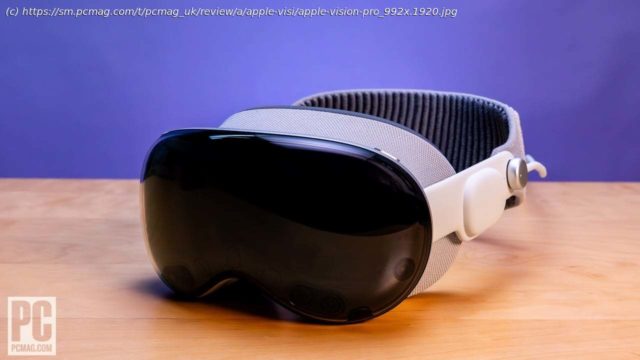An incredible leap in AR and VR interactivity
I’ve been listening to rumors about Apple launching a virtual reality headset (VR) for half of my 20-year career writing about technology, but even I was surprised when it announced the Vision Pro. It’s the company’s first foray into the head-mounted display space, and a wildly ambitious one. Despite Apple’s attempts to spin it as a « spatial computer » and avoid describing it as any sort of “reality” headset, it’s ultimately both a VR and augmented reality (AR) device. It’s also the most advanced device of either category to ever hit the market.
Starting at $3,499, the Vision Pro costs several times more than its closest competitor, the $1,499.99 Meta Quest Pro. For the money, you get the sharpest head-mounted display there is, with the best camera and sensor technology, and processing power that rivals an iPad Pro or a MacBook Air. It also offers the best control system I’ve ever experienced with AR or VR, one that masterfully embraces eye and hand tracking for a natural, intuitive interface that doesn’t require any physical controllers.
The Vision Pro is more polished, more stable, and more flexible than I could have expected from Apple’s first entry in this category, and it truly impresses. It isn’t perfect, though, due to a few design frustrations and software availability limitations. None of those issues are as showstopping as its price, however. While indeed revolutionary, the Vision Pro is so wildly expensive that only the most dedicated and well-heeled of early adopters will actually consider buying it.Want to Order? Scan Your Head
The base Vision Pro has 256GB of storage, but 512GB and 1TB versions are also available for $3,699 or $3,899, respectively. For this review, we purchased the base model.
Apple only offers the Vision Pro directly from its website or its retail stores. That’s because there’s an entire fitting process required to make sure the headset sits snugly against your face. If you order online, you need an iPhone or an iPad with Face ID. The Apple site will show a QR code to scan with your device, after which it will scan your face and head. If you buy the headset in a store, someone there will do the fitting for you. Design: Apple’s Aesthetic With a Finicky Fit
The Vision Pro looks and feels like an Apple product through and through. In fact, with its aluminum body, glossy black full-face glass front, and Digital Crown, it almost resembles a giant, curved Apple Watch. The visor itself feels very solid thanks to its metal-and-glass design, which also gives it a premium appearance that headsets from Meta, PlayStation, and Valve lack.
This design also makes the Vision Pro front-heavy. At approximately 22 ounces depending on headband configuration, it weighs slightly less than the Quest Pro (25.5 ounces), but more than the Quest 3 (18.2 ounces). Its weight wouldn’t be a problem if it was distributed well, but there’s no vertical strap running from the visor to the back of the head like there is on the Quest 3, or rigid support like on the PS VR2 or Quest Pro.
Two headbands are included with the Vision Pro, but neither offer quite as much balance or support as I would like. The Solo Knit Band is a wide headband with breathable, elastic fabric that fits around the back of the head. A knob on the side adjusts the headband by loosening or tightening two cords that run around the edges of the fabric.
As an alternative, the Dual Loop Band has a much more conventional headband design, with two adjustable straps that run horizontally over the back and the top of the head that can be adjusted with Velcro. You can easily swap between the two headbands by pulling the orange tabs next to the magnetic interlocks that securely connect each side to the visor. Unfortunately, the Solo Knit Band doesn’t have a rigid support for the back of the head and the overhead headband on the Dual Loop Band runs horizontally over the top of the head (parallel to the visor) instead of vertically, so neither provides ideal stability. The Vision Pro stays put on my face, but I found myself regularly tweaking the headbands and wiggling the visor to adjust the fit and positioning.
Despite its slight weight and balance issues, the Vision Pro’s premium materials help prevent any significant discomfort. Two light seal cushions, or padded memory foam bands that sit between the headset and your face, are included, and they feel quite cool and pleasant. They attach to the headset with magnets, though not as securely as the tab-locking headbands, and sit on top of a rigid, fabric-covered light seal that keeps the lenses a short, visually comfortable distance away from your eyes.
On the visor itself, the Apple Watch-like Digital Crown sits on the upper right corner, and a button resides on the upper left. Between them are two large vents for cooling. The bottom edge has no controls, but features two large speaker grilles, several tiny microphones, and two cameras that face downward.
The glass face of the Vision Pro features four barely visible cameras and an outward-facing display that glows and shows a projection of your eyes when you’re looking out at the real world through the integrated cameras, a feature Apple calls EyeSight. It gives the impression that the Vision Pro is a transparent AR device and that people around you can look directly at you, even when you’re wearing it. That isn’t too off the mark, given the headset’s impressive passthrough view, which streams real-time video from the external cameras to the internal display so you can see your physical surroundings. The EyeSight view from the outside isn’t very clear or bright, but it at least gives others some sense that you’re looking at them through the mask. Battery Life: Two Hours
Instead of a built-in battery, the Vision Pro uses a separate battery pack (included) that attaches to the headset through a circular connection on the left side. It isn’t magnetic, just a rock-solid metal connector that twists 90 degrees to keep it secure. The battery itself is permanently attached to a fabric-wrapped, four-foot-long cable, and is a hefty little hunk of aluminum. It’s a bit smaller than an iPhone, but heavier than one. Typical of Apple’s design aesthetics, the battery pack is sleek, smooth, and simple, featuring just the cable, a USB-C charging port next to where the cable is attached, and a status LED between them.
Because the battery pack is basically a phone-sized aluminum soap bar that lacks any controls, it isn’t meant to be held while you use the Vision Pro. You can slip it in a pocket or place it next to you, but there’s no clip or holder for it. If you want to put the battery pack on your belt, you can get a $49.95 Belkin battery holder.
Battery life remains the biggest weak point for standalone AR/VR headsets across the board, and the Vision Pro is no different. Apple estimates that you can get up to two hours of general use (consisting of video playback, internet browsing, video capture, and FaceTime) or 2.5 hours of straight video playback on the Vision Pro. You can use the headset while you charge the battery, and additional batteries are available for $199 each, but you can’t hot-swap batteries; switching between them requires shutting down and restarting the Vision Pro.
In testing, I could sit back and browse the web or play games on the Vision Pro for more than an hour before the battery dipped much below the halfway mark. You can’t watch a full movie on a single charge, but at least the battery can remain plugged into a power outlet while you use the Vision Pro. Keeping it plugged in and staying seated for long sessions doesn’t bother me any more than trying to find a place for the battery pack when I’m moving around.
No case is included with the Vision Pro, which is disappointing for the price. If you want to carry it around safely, Apple offers a travel case for a stiff $199.Hardware: Mac-Worthy Silicon
The Vision Pro’s steep price can at least partially be explained by its hardware.
Two chips drive the Vision Pro, an Apple M2 and an R1. The M2 is the familiar system on a chip found in the iPad Pro, the 2022 MacBook Pro, the 2023 MacBook Air, and the 2023 Mac mini. It features an 8-core CPU, a 10-core GPU, and a 16-core Neural Engine, and is paired with 16GB of RAM. It’s a desktop-worthy chip, even if its specs are eclipsed by beefier M2 Pro, Max, and Ultra variants, and the M3 series Apple launched in late 2023.
The M2 has the Vision Pro’s GPU, but all of the camera processing is performed by the separate R1 chip. It manages the input from the headset’s dozen cameras, five sensors, and six microphones, and Apple claims it can stream video of the outside world to the display with a lag of only 12 milliseconds. Since augmented reality is such an important aspect of the Vision Pro as a spatial computer, this dedicated chip is vital and lets the M2 devote its resources to more conventional processing tasks.
For connectivity, the Vision Pro has Wi-Fi 6 and Bluetooth 5.3. It surprisingly doesn’t support Wi-Fi 6E.Display and Cameras: Nearly as Good as the Naked Eye
For the display, the Vision Pro features a micro-OLED projection system with 90, 96, and 100Hz refresh rates. Apple doesn’t give the exact resolution, but states that it shows 23 million pixels, which is about three times as many as 4K video (8.3 million pixels). It’s bright, colorful, and sharp, far exceeding the clarity of the second-highest-resolution headset we’ve tested, the 6-million-pixel-per-eye HTC Vive Pro 2.
Just like Apple doesn’t describe the Vision Pro’s exact resolution, it also doesn’t specify its field of view. It’s certainly very wide, comparable with any other VR headset and much wider than the 30- to 60-degree fields of view of AR smart glasses.






